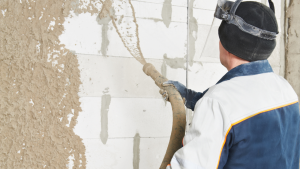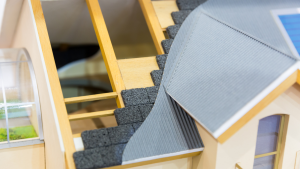Taking good care of your stucco is important for making it last a long time. If you give your stucco the right attention, it can be like a long-lasting investment. Our team at East Brunswick Stucco & EIFS understands that taking care of it early on is essential to stop problems and keep your stucco looking great. Here, we share helpful tips to protect your stucco and make sure it stays appealing for a long time.
Mastering Stucco Maintenance: Key Strategies for Longevity
Stucco exteriors are renowned for their durability and timeless appeal. However, like any exterior material, they necessitate proper care to retain their charm and structural integrity. By adhering to these critical maintenance tips, you can shield your investment and thwart common stucco problems.
Embrace Regular Inspections
- Consistent inspections are the cornerstone of effective stucco maintenance.
- Dedicate time to evaluate your stucco exterior for indications of damage, cracks, or discoloration.
- Detecting issues early on enables swift rectification and prevents minor concerns from escalating.
Monitor Moisture Intrusion
- Moisture intrusion ranks among the most prevalent issues encountered by stucco exteriors.
- Regularly scrutinize your stucco for evidence of water damage, including stains, mold growth, or damp patches.
- Addressing moisture problems promptly can forestall costly repairs down the road.
Prioritize Caulking and Sealing
- Proper caulking and sealing play a pivotal role in fortifying your stucco exterior against the elements.
- Ensure that all joints, seams, and gaps are adequately sealed to thwart water infiltration.
- Routinely assess caulking for wear and promptly reseal compromised areas.
Tackle Cracks Swiftly
- Cracks can emerge in stucco due to factors such as settling, temperature fluctuations, and structural shifts.
- Regularly inspect your stucco for cracks and address them promptly to stave off further deterioration.
Proceed with Careful Power Washing
- Power washing effectively rids surfaces of grime but should be approached with caution.
- Employ a low-pressure setting and maintain a suitable distance from the surface to prevent damage.
- Consider consulting professionals for secure and efficient power washing.
Implement Preventive Measures
- Taking proactive measures can significantly prolong your stucco exterior’s life.
- Trim nearby vegetation to prevent overgrowth from touching and potentially harming the stucco.
- Ensure proper drainage to channel water away from the stucco façade, curbing moisture accumulation.
Opt for Professional Inspection and Maintenance
- Regular professional inspection and maintenance are vital for thorough assessments and addressing potential concerns.
- Enlisting professional services can provide you with reassurance and adept recommendations for sustained stucco care.
Effective Stucco Maintenance Techniques: The Art of Cleaning
Cleaning lies at the heart of effective stucco maintenance.Various cleaning techniques might be employed depending on what you need: regular cleaning, advanced cleaning, or outdoor cleaning.
Routine Cleaning
- Stucco’s porous nature attracts dirt, both indoors and outdoors.
- For regular indoor stucco cleaning, use a soft-bristled nylon brush dipped in warm water.
- Gently scrub the surface, using a damp brush, and finish by wiping off excess dirt with a microfiber cloth.
Advanced Cleaning
- Persistent stains call for a more thorough strategy using trisodium phosphate (TSP).
- Use TSP with proper precautions, including ventilation and protective attire.
- Mix TSP with water in a 15-to-1 ratio; using a nylon brush, apply the solution, then allow it to dry completely.
Outdoor Cleaning
- Caring for outdoor stucco is an ongoing endeavor due to its exposure to the elements.
- Make use of a spray garden hose or a power washer nozzle.
- Begin by misting the stucco to dampen it before using a focused spray to clean the surface from top to bottom.
- Emphasize downward spraying to prevent dirt accumulation.
- After washing, inspect the stucco for residual dirt and, if needed, gently scrub using a brush.
Understanding the Importance of Stucco Maintenance
Your stucco is like the face of your home, making a first impression on visitors and potential buyers. If you take good care of it, it shows you pay attention to details and care about your home. But if you ignore it, it might worry people and make them less interested. So, looking after your stucco is not just a task; it’s a way to make sure your home looks nice, keeps its value, and stays strong. Doing things early to solve problems is not just work; it’s an investment to keep your stucco looking fantastic.
In essence, stucco maintenance embodies a commitment to preserving the essence of your home. Taking care of your stucco is like a protective shield for your home. It makes your investment last longer, improves how your home looks, and ensures it stays in good shape. If you check out your stucco from the street or plan to sell your home in the future, taking good care of it by doing regular maintenance shows that you love your home and want it to stay looking fantastic.
Place Your Trust in East Brunswick Stucco & EIFS
We at East Brunswick Stucco & EIFS comprehend the importance of meticulous stucco maintenance. Our expert team is here to help you keep your stucco looking nice and strong. Whether you need inspections, repairs, or advice on taking care of it, we’re your reliable friends in stucco care. Reach out to us today to protect your stucco and enjoy a beautiful exterior that lasts a long time.




